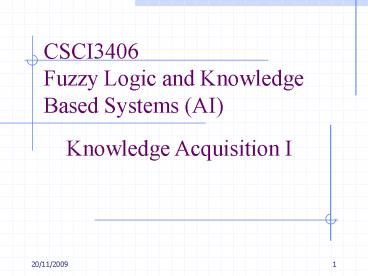CSCI3406 Fuzzy Logic and Knowledge Based Systems AI PowerPoint PPT Presentation
1 / 14
Title: CSCI3406 Fuzzy Logic and Knowledge Based Systems AI
1
CSCI3406 Fuzzy Logic and Knowledge Based Systems
(AI)
Knowledge Acquisition I
2
Introduction
- We look at the different types of knowledge
- We identify what we mean by knowledge
acquisition? - The difficulties of acquiring knowledge is
discussed. - Key players, who affect the process, and their
roles are identified and discussed.
3
Topics of Discussion
- Knowledge acquisition.
- Difficulties in acquiring knowledge.
- Key players.
4
Knowledge
- Knowledge is information of which someone is
aware. Knowledge is also used to mean the
confident understanding of a subject, potentially
with the ability to use it for a specific
purpose. (http//en.wikipedia.org/wiki/Knowledge)
- Other definitions
- knowledge 'tracks the truth (Robert Nozick)
- It is suggested that our definition of knowledge
needs to require that the believer's evidence is
such that it logically necessitates the truth of
the belief (Richard Kirkham) - Knowledge is "information combined with
experience, context, interpretation, and
reflection. It is a high-value form of
information that is ready to apply to decisions
and actions." (T. Davenport et al., 1998) - "Explicit or codified knowledge refers to
knowledge that is transmittable in formal and
systematic language. Tacit knowledge has a
personal quality, which makes it hard to
formalize and communicate." (I. Nonaka, 1994)
5
Knowledge
- Explicit knowledge is referred to the knowledge
which has been articulated, codified and stored
in certain mediums. The most common form of
explicit knowledge are manuals, documents,
procedures and stories. The are also other forms
of knowledge can be in the form of audio vision
and other multimedia form of representations. A
work of art and product design can be seen as yet
another forms of explicit knowledge where human
skills, motives and knowledge are externalized. - Tacit Knowledge Tacit knowledge consists often
of habits and culture that we do not recognize in
ourselves. The tacit aspects of knowledge are
those that cannot be codified, but can only be
transmitted via training or gained through
personal experience. Tacit knowledge has been
found to be a crucial input to the innovation
process. A nations ability to innovate depends
on its level of tacit knowledge of how to
innovate (conduct research, develop prototypes of
new products processes, adapt these prototypes
into models fit for mass-production) and of how
to implement innovations into manufacturing,
defense, communications, transportation, etc.
Ref http//en.wikipedia.org/
6
Knowledge
- Information is data endowed with relevance and
purpose. Converting data into information thus
requires knowledge (Peter Drucker) - Example to define knowledge, information and
data How to bake a cake (Mezei, D. , 2003) - Data - the different ingredients i.e. flour,
water, eggs, sugar etc. - Information - the recipe i.e. mix flour, eggs and
water, preheat oven to 400 etc. - Knowledge - the know how the cook uses to bake
the cake, to best utilize the data and
information available
7
Knowledge acquisition
- Definition - The process of acquiring,
organizing, and studying knowledge. - Two main types of sources of knowledge
- Documented (which can take many forms) and
- Undocumented (usually in the expert's mind).
- There are two types of knowledge
- shallow knowledge
- deep knowledge.
8
Knowledge acquisition
- Shallow knowledge An expert has a base
understanding of the subject, some of which could
be described as general. - Example surface level information might be
represented as If the weather is bad then stay
in bed.
9
Knowledge acquisition
- Deep Knowledge This is the knowledge that has
been acquired by years of experience and study
and is the detailed core of the knowledge base.
- Example if we take the weather example again, we
may ask for instance what do we class as bad
weather, why does bad weather cause us not to
want to go out, what's so good about staying in
bed etc. Frames semantic networks enable us to
represent deeper knowledge.
10
Knowledge acquisition
- Categories of Knowledge (three main ones)
- Declarative - i.e. descriptive knowledge, facts.
- Procedural - how things are done, how to use the
declarative knowledge. - Semantics - consider words symbols what they
mean, how they are related manipulated.
Reflects cognitive structure.
11
Difficulties of acquiring knowledge
- Why is it difficult to transfer knowledge?
- Hard to get experts to express how they solve
problems - Compiling and refining all experts knowledge
- Bringing together the ideas of all those involved
in the knowledge transfer process. - Representation on machine requires detailed
expression i.e. at a very low level. Must be
represented in a structured way.
12
Key Players involved in developing an expert
system are
- Expert(s) who have the knowledge of an area being
considered for designing a KBS for - Knowledge Engineer(s) who collect the information
that the client wants in the system and then put
it all into the program in a logical way. - Example if a client, who is an expert in cars,
wanted a program to identify different types of
cars, then the knowledge engineer will need to
collect the necessary information about different
cars and their features. It is up to the
knowledge engineer to capture the knowledge of
the domain expert into a knowledge base, which is
then used to build up an expert system. - User(s)
- Programmers
- Management
13
Conclusion
- Defined what we mean by knowledge and its
acquisition. - Why is it difficult to acquire knowledge?
- Key players who are important in the process of
knowledge acquisition.
14
Next Steps
- Next
- Knowledge acquisition process.

